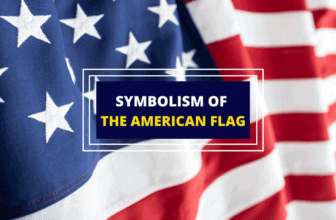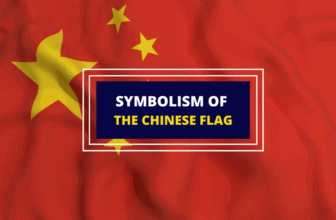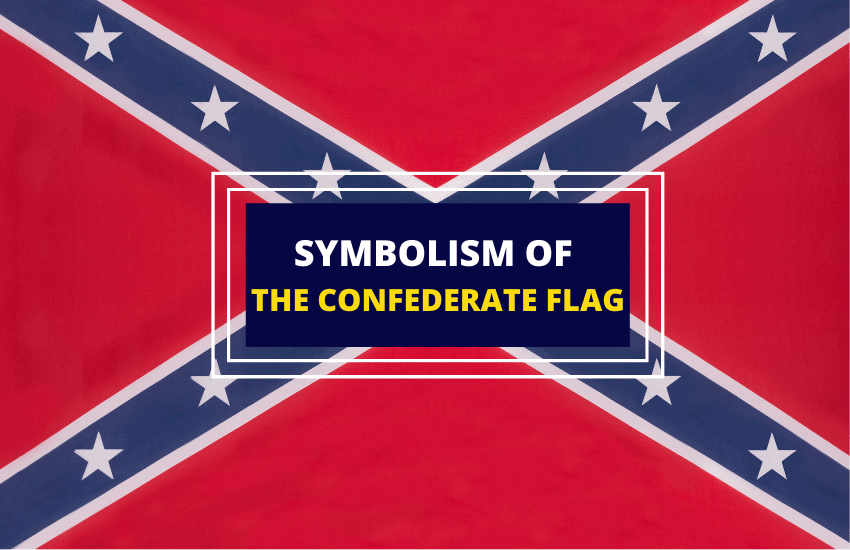
Table of Contents
History buffs and those who have grown up in the United States are no strangers to the Confederate flag. Its famous blue X-shaped pattern against a red background is often found on license plates and bumper stickers. Others also hang it outside government buildings or their own homes.
If you’re not familiar with its history, you probably don’t know why some people find the Confederate Flag offensive. Read on to find out more about the controversial history of the Confederate Flag and why some want it banned.
Symbolism of the Confederate Flag
In a nutshell, the Confederate Flag is viewed today as a symbol of slavery, racism and of white supremacy, although in the past it was predominantly a symbol of Southern heritage. Like many other symbols that have changed meaning over time (think the Swastika or the Odal Rune) the Confederate Flag also has undergone a transformation.
What Is the Confederacy?
The Confederate States of America, otherwise known as the Confederacy, was a government of 11 Southern states that withdrew from the Union during the American Civil War.
Originally, there were seven states: Alabama, South Carolina, Florida, Georgia, Texas, Louisiana, and Mississippi. Four states from the upper South joined them when the war began on April 12, 1861: Arkansas, Tennessee, Virginia, and North Carolina.
The withdrawal from the Union was due to the belief that Abraham Lincoln’s presidency threatened their way of life, which was highly dependent on the concept of slavery. In February 1861, they began the resistance by establishing a provisional government in Alabama. This was eventually replaced by a permanent government in Virginia a year later, with President Jefferson Davis and Vice President Alexander H. Stephens as its fierce leaders.
The Evolution of the Confederate’s Battle Flag
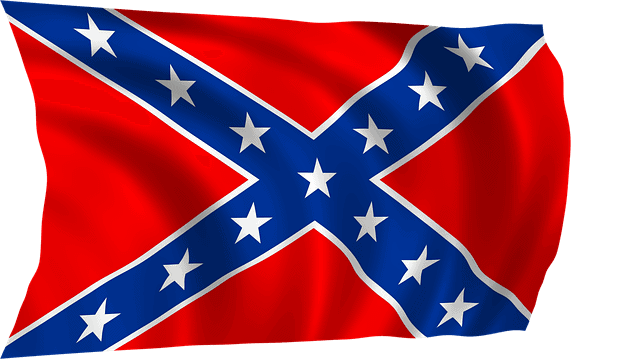
When the Confederate rebels first opened fire on Fort Sumter in 1861, they flew a historic blue banner with a single brilliant white star. Popularly known as the Bonnie Blue Flag, this banner became a timeless reminder of the first battle that marked the start of the Civil War. It also became a symbol of secession as Southern troops continued to wave it on battlefields.
Eventually, the Confederate States of America realized that they needed symbols that would represent their sovereignty. This led to the introduction of their government stamps and the Confederate flag, which was then known as the Stars and Bars. It featured 13 white stars against a blue background, with each star representing a Confederate state, and 3 stripes, 2 of which were red, and one white.
While it had a distinctive design, it looked extremely similar to the Union’s flag when viewed from a distance. This caused major problems because it was hard to tell the difference between the two during battles. One infamous incident occurred when some troops mistakenly fired at their own men during the Battle of First Manassas in July 1861.
To avoid further confusion, General Pierre Beauregard of the Confederacy commissioned a new flag. Designed by William Porcher Miles, one of the congressmen of the Confederate, the new flag had a blue X-shaped pattern called St. Andrew’s Cross against a red background. This pattern was embellished with the same 13 white stars that the original flag had.

Although this version of the Confederate flag was extremely popular, it wasn’t considered the official government or military symbol of the Confederacy. Future designs of the Confederate banner incorporated this section on its left-hand corner, with the addition of a white background that signified purity.
This was where the whole controversy started.
Many have contended that the white background represented the supremacy of the white race and the inferiority of the colored race. This is why many consider the Confederate flag racist and offensive. In fact, some hate groups continue to draw inspiration from the Confederate flag and use it to get their principles across.
The End of the Civil War
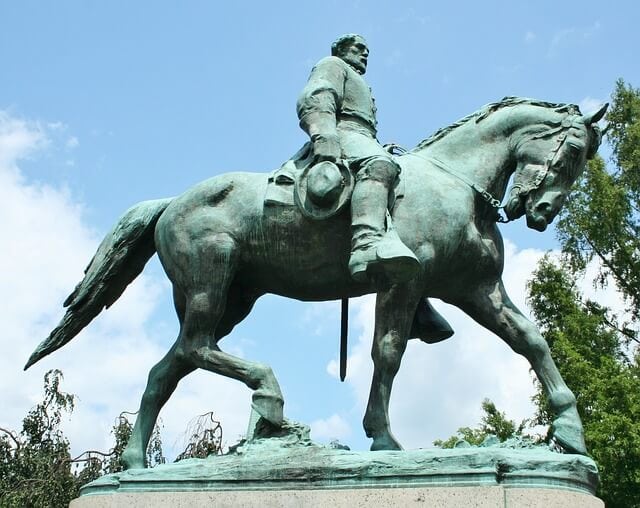
Many armies of the Confederacy drew the Confederate’s flag during battles. General Robert E. Lee led one of these armies. He was known for leading soldiers who kidnapped free black men, sold them as slaves, and fought to keep slavery in place.
General Lee’s army surrendered at the Appomattox Court House, where they were granted parole and allowed to return to their homes. Thousands of Confederate armies remained defiant, but most white southerners believed that his army’s surrender had inevitably brought the Civil War to an end.
Ironically enough, General Lee was not a huge fan of the Confederate flag. He felt that it was such a divisive symbol that made people remember the pain and agony that the Civil War had caused.
The Lost Cause
In the early 20th Century, some white Southerners started perpetuating the idea of a Southern state that fought the Civil War to protect the states’ rights and way of life. They ultimately changed the narrative and denied their goal to uphold slavery. Historian Caroline E. Janney believes that this Lost Cause myth started as the Confederates were struggling to accept their defeat.
Southerners started to commemorate the dead when the war ended. Organizations like the United Daughters of the Confederacy celebrated the life of Confederate veterans by writing their own version of history and making it the official doctrine of Southern Confederate states.
At the same time, Confederate monuments started dominating the South and its battle flag was incorporated into Mississippi’s state flag.
The Confederate Flag After the Civil War
After the Civil War, different organizations against civil rights groups continued to use the Confederate flag. The Dixiecrat political party, which aimed to uphold racial segregation and opposed the rights being given to the Black people, was one of these groups. They used the Confederate flag as a symbol of their resistance to the US federal government.
The Dixiecrats’ use of the Confederate Flag as a symbol of their party led to the banner’s renewed popularity. It began appearing in battlefields, college campuses, and historical sites once again. Historian John M. Koski noted that the Southern Cross, which once symbolized rebelliousness, became a more popular symbol of resistance to civil rights by then.
In 1956, a Supreme Court ruling declared racial segregation in schools to be illegal. The State of Georgia expressed its resistance to this ruling by incorporating the Confederacy’s battle flag into its official state flag. Moreover, members of the Ku Klux Klan, a white supremacist group, were known to wave the Confederate flag as they harassed black citizens.
In 1960, Ruby Bridges, a six-year-old child, became the first Black child to attend one of the all-white schools in the South. People who were against this protested, throwing stones at her while waving the infamous Confederate flag.
The Confederate Flag in Modern Times
Today, the history of the Confederate flag is no longer focused on its early beginnings but more on its use as a rebel flag. It continues to represent the resistance against social equity among all races. This is why civil rights groups were against it being proudly displayed in the statehouse of South Carolina.
The flag has been involved in many notorious events. For example, Dylann Roof, a 21-year-old, a white supremacist and neo-Nazi, who became infamous for shooting nine black people to death in June 2015, used the flag to express his intention to instigate a war between races. There are photographs of him burning and stomping on the American flag while waving the Confederate Flag.
This started another debate on the meaning of the Confederate Flag and how it is used in public places. Activist Bree Newsome responded to Roof’s heinous crime by ripping the Confederate flag in South Carolina’s statehouse. It was permanently taken down a couple of weeks after the violent shootings.
It’s listed among other hate symbols on the database of the Anti-Defamation League, a leading anti-hate organization.
How Confederate Flags Were Banned
A year after the brutal killings in Charleston Church, the United States banned the use of Confederate flags in cemeteries that were being run by the Veterans Administration. Major retailers like eBay, Sears, and Wal-Mart also removed it from their aisles, which eventually prompted flag manufacturers to cease its production.
Despite all these changes, there are still people who defend the Confederate flag and do not consider it a racist symbol. Nikki Haley, a United Nations ambassador and South Carolina governor, also received criticism for defending the flag. According to her, the people of South Carolina consider the Confederate flag as a symbol of service and sacrifice and heritage.
Wrapping Up
Throughout history, the Confederate flag has consistently been a highly divisive symbol. While southerners who defend the flag believe that it represents their heritage, many African Americans see it as a symbol of terror, oppression, and torture. Civil rights leaders firmly believe that those who continue to draw the flag are indifferent to the pain and suffering that the Black people endured and continue to live through up to now.




